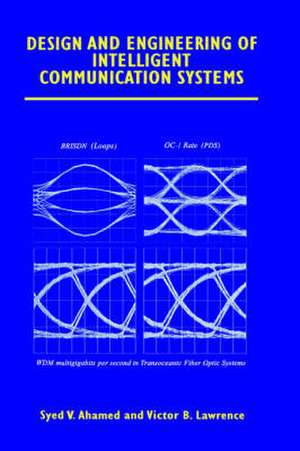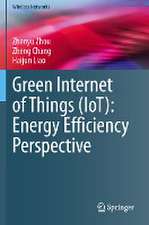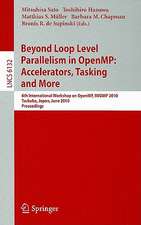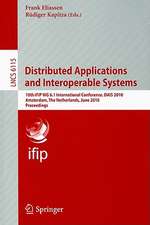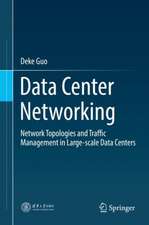Design and Engineering of Intelligent Communication Systems
Autor Syed V. Ahamed, Victor B. Lawrenceen Limba Engleză Hardback – 27 feb 1997
| Toate formatele și edițiile | Preț | Express |
|---|---|---|
| Paperback (1) | 1292.54 lei 6-8 săpt. | |
| Springer Us – 7 oct 2012 | 1292.54 lei 6-8 săpt. | |
| Hardback (1) | 1299.31 lei 6-8 săpt. | |
| Springer Us – 27 feb 1997 | 1299.31 lei 6-8 săpt. |
Preț: 1299.31 lei
Preț vechi: 1624.14 lei
-20% Nou
Puncte Express: 1949
Preț estimativ în valută:
248.63€ • 265.86$ • 207.30£
248.63€ • 265.86$ • 207.30£
Carte tipărită la comandă
Livrare economică 18 aprilie-02 mai
Preluare comenzi: 021 569.72.76
Specificații
ISBN-13: 9780792398707
ISBN-10: 079239870X
Pagini: 676
Ilustrații: XXXIX, 676 p.
Dimensiuni: 155 x 235 x 38 mm
Greutate: 1.18 kg
Ediția:1997
Editura: Springer Us
Colecția Springer
Locul publicării:New York, NY, United States
ISBN-10: 079239870X
Pagini: 676
Ilustrații: XXXIX, 676 p.
Dimensiuni: 155 x 235 x 38 mm
Greutate: 1.18 kg
Ediția:1997
Editura: Springer Us
Colecția Springer
Locul publicării:New York, NY, United States
Public țintă
ResearchDescriere
FIGURE 18.13e. Detector Output. ..................................................................... 618 FIGURE 18.14a. WDM Energy Distrubution into the Fiber ........................... 619 FIGURE 18.14b. Fiber Loss for the WDM Band .............................................. 619 FIGURE 18.14c. Fiber Group Delay Distribution ............................................ 619 FIGURE 18.14d. Receive Energy Distribution ................................................. 619 FIGURE 18.15a. Channell Eye Diagram at PIN Diode ................................. 621 FIGURE 18.15b. Channel 2 Eye Diagram at PIN Diode ................................. 621 FIGURE 18.15c. Channell System Output at Detector ................................. 621 FIGURE 18.15d. Channel 2 System Output at Detector ................................. 621 PREFACE The emerging networks in our society will touch upon the life of everyone. These networks have started to bring about an immense information revolution. The revolution within our intellectual life will be similar to the materialistic revolution that followed the invention of the steam and the internal combustion engines. From the perspective of the 1980s, the information networks are indeed evolving and their influence can only be gradual. However, the strides of progress are accelerating in the 1990s. Networks in our society offer the most candid area of convergence for the computer and the communication technologies. The two technologies are mature in their own right. However, there are a few major factors that prevent network engineers from constructing modern communication systems from components borrowed from each of these two technologies: • Major innovations are happening. • Specialized components evolve in synergistic patterns. • New technologies emerge. • Inquisitive minds cross disciplinary barriers.
Cuprins
Table of Figures. Preface. Part I: Overview of the Communication Facilities. 1. Basic Communication Networks. 2. FM Techniques in Existing Networks. 3. Video and TV Environment. 4. Current Digital Networks. Part II: The Metallic Media: The Physical Environment. 5. Subscriber Loops. 6. Operational Environment for the HDSL. Part III: The Metallic Media: The Computational Environment. 7. Simulation and CAD Aspects. 8. Data Bases and Their Management for DSL Design Studies. 9. Simulation Techniques for the QAM (2D) Code. 10. Computer Based Optimization Techniques for HDSL Design. Part IV: System Performance from Very Low to Very High Rates. 11. Data Up to PRISDN Rates. 12. Data at PRISDN Rate. 13. Performance of Trellis Coding. 14. Digital Subscriber Line (HDSL and ADSL) Capacity. Part V: Recent High-Speed Network Environments. 15. Knowledge Highways. 16. Impacts of Fiber Optic Technology. 17. Optical Lightwave Systems in Existing Networks. 18. A PC Based Fiber Optic CAD Environment. Glossary. Index. Authors' Biographies.
